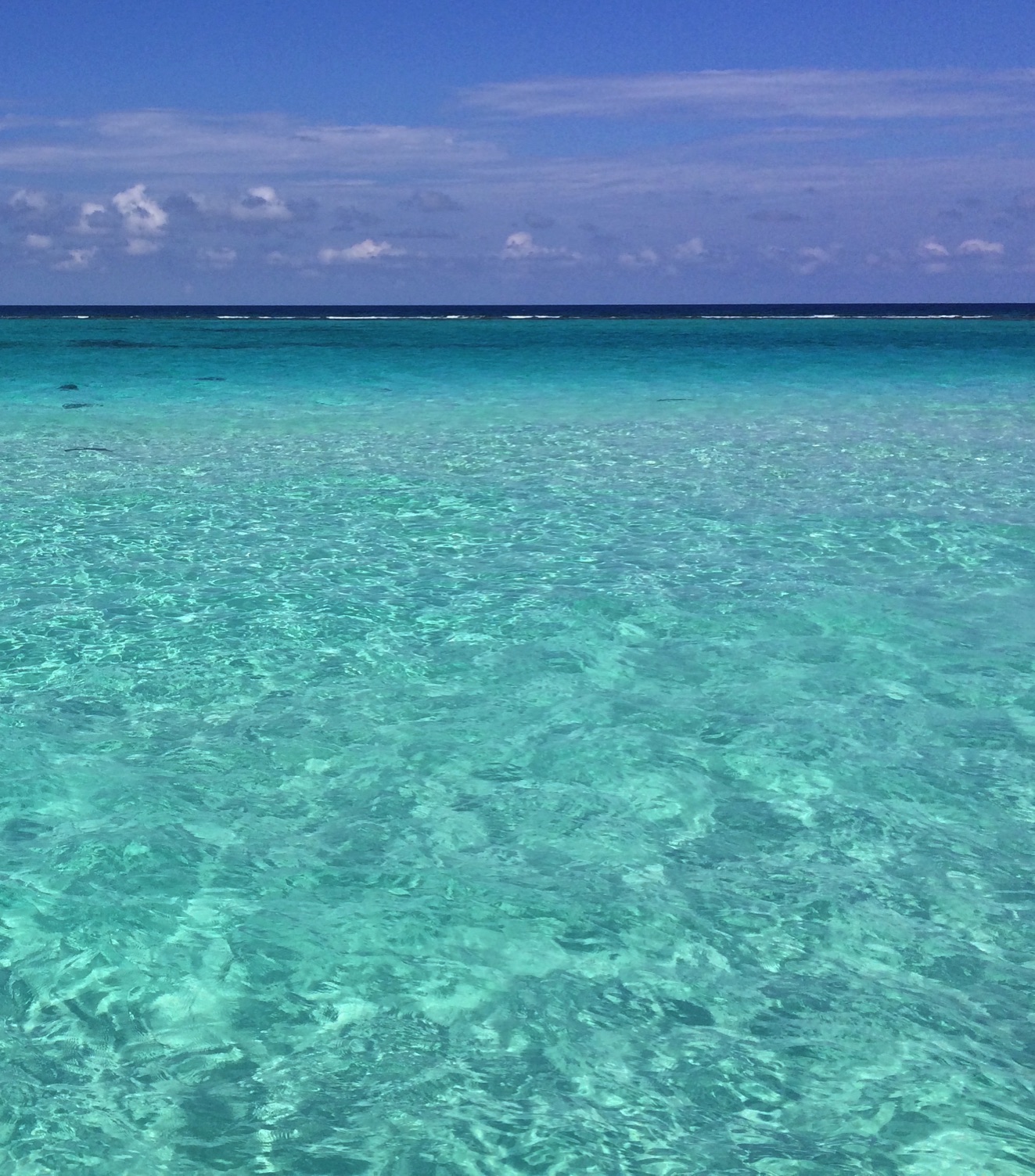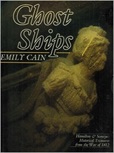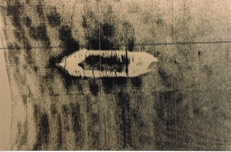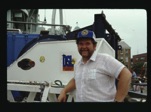MILESTONE CHRONOLOGY 1981 - 1990
1981 - The Institute of Oceanographic Sciences' long-range sidescan sonar 'Gloria' was operated over almost 20,000 km of ship track.
Klein Associates introduces the first side scan sonar/sug-bottom profilar modular kit for mountins on human occupied submersibles, remote operated vehicles and autonomous vehicles.
-Jessup Marine Recoveries Ltd. used a Klein 531 side scan sonar to find the HMS Edinburgh, a British light cruiser, that was sunk in the Barents Sea by German torpedoes on April 29, 1942. The British warship carried a cargo of over 400 gold bars from the Soviet Union that were bound to the United States to pay for American-supplied military equipment.
1982 - George A. Gilmour of Westinghouse Electric Corp., Oceanic Division presents a paper “Hybrid Focusing for Side-Look Sonar” at the Acoustical Society of America, Orlando, Florida.
-Klein Associates introduces its new Microprofiler, a very high resolution echosounder that can be combined with a Klein Side Scan Sonar and/or sub-bottom profiler. This will allow outlining pipeline outlines to be overlayed on the sonar trace.
-Bill Key from Klein Associates demonstrates the ability of a Klein 500kHz side scan sonar to find lost channel buoys.
-The Coastal Engineering Research Center, Cleveland, Ohio employed a Klein 100/500 kHz side scan sonar to inspect a breakwater on Lake Erie.
-Charles Mazel of Klein Associates supervised a project by Hydromar, Quebec City to ascertain the ability of a 500 kHz Klein Side Scan Sonar to ascertain damage to damage to underwater portions of piers.
Garry Kozak from Klein Associates uses a Klein Side Scan Sonar to find the wreck of the steamer Atlantic lost in 1852 in Lake Erie.
1983 - The March 1983 issue of National Geographic magazine published a story that described the discovery, using a Klein side scan sonar, of two War of 1812 schooner shipwrecks—USS Hamilton and USS Scourge. The two American warships were lost on Lake Ontario in Canadian waters during a storm on August 8, 1813. Dr. Daniel A. Nelson, working under the auspices of the Royal Ontario Museum, used a magnetometer in 1973 to first locate the area near the shipwrecks. However, it was not until 1975 that a Klein sonar, operated by Klein Associates' Garry Kozak, first “imaged” the two historic warships helping to acquire their precise location
-Garry Kozak used a Klein side scan sonar and after a 10 year “on-and-off” search discovered the Dean Richmond steamboat shipwreck lying in Lake Erie. The historic watercraft sank in mid-October 1893.
-A Klein Side Scan Sonar was used to locate the remains of Korean Airlines Flight KAL-007 which was shot down by Soviet aircraft over Sakhalin Island in the Sea of Japan.
-A Klein Side Scan Sonar was used to locate the wreckage of the United States Drillship Glomar Java Sea in the South China Sea, 65 nautical miles south-southwest of Hainan Island, People's Republic of China.
-A horse-powered ferry was found in Burlington Bay, Lake Champlain by the Lake Champlain Maritime Museum using a Klein side scan sonar.
1984 - Clive Cussler's National Underwater and Marine Agency (NUMA) used a Klein side scan sonar operated by Klein Associates engineer Tom Cummings to find the paddlewheel steamboat Lexington, lost in Long Island Sound. In 1840, the steamer, originally built for Cornelius Vanderbilt as his personal yacht, caught fire and sank. Sources vary, but only 4 of the 154 passengers and crew survived the maritime disaster.
-A Klein Side Scan Sonar was used at the Long Island Lighting Company's Shoreham Power Station in New York to inprect the condition of the underwater diffuser pipe nozzles.
-Klein Associates introduced its Model 660 Multiplexer to combine on one coax the signals from a side scan sonar and sub-bottom profiler with cable lengths more than 3,000 meters.
-A Klein Side Scan Sonar was used by Moss Landing Marine Laboratories to record gray whale feeding grounds.
-The U.S. Army Corps of Engineers in Little Rock, Arkansas used a Klein Side Scan Sonar to locate a string of barges that broke loose on the Arkansas River.
-A Klein Side Scan Sonar was used to locate a large anchor and chain on the Suez Canal that had been blocking ship traffice.
-The Norwegian Polar Research Institute used a Klein Side Scan Sonar to map ocean botton scouring in front of an active glacier in Norway.
1985 - Peter Fox writes his seminal PhD thesis “An Electronically Focused Multiple Beam Side Scan Sonar” at the University of Cape Town.
-While investigating a Klein Side Scan Sonar trace in July 20, 1985., famed treasure hunter, Mel Fisher, locates the long-sought "Nuestra Senora de Atocha" 1622 shipwreck on July 20, 1985.
-The French SAR (Systeme Acoustique Remorque), first introduced in 1985, is operated by IFREMER (Institute Francaise pour le Recherche de Mer) for both academic and government research. Sidescan sonar frequencies are 170 kHz starboard and 190 kHz port. This sonar has been used in connection with the Air France Flight 447 crash search.
-Klein Associates, Inc. published its much sought-after training manual—Side Scan Sonar Record Interpretation. Klein Associates' Charles Mazel prepared the 98-page publication. The manual, which was sold by the company, is believed to have been the first publication on instruction of the principles, applications, and interpreting side scan sonar records.
-Klein also announces the first Side Scan Sonar Record Interpretation course after the Offshore Technology Conference in Houston.
-A Klein side scan sonar played a critical role in the discovery
of the famed ocean liner—RMS Titanic which had hit an iceberg
and sank in the North Atlantic in 1912. For an expedition headed
.by Dr. Robert Ballard of the Woods Hole Oceanograhic Institution, a special deep Klein side scan sonar, operated by Klein engineer Terry Snyder, was mounted on the deep water-towed apparatus—ARGO. ARGO was also equipped with underwater television,lights, and other technical gear. In the middle of the night the sonar picked up signs of a debris field and captain Richard Bowen was notified to steer the ship in the direction of the debris. Shortly after a boiler was seen on the underwater television confirming that the wreck of the Titanic had been found.
-The Geldermalsen was a merchant vessel owned by the Verenigde Oost Indische Compagnie, VOC or Dutch East India Company. It sank during a storm in 1752, sailing from the southern Chinese port of Canton (Guangdong) to Amsterdam via Indonesia. According to the ship manifesto and survivors' accounts, the ship was laden with tea, gold, raw silk and Chinese export porcelain. In 1985, Hatcher, together with his partner Max de Rham, embarked on the hunt for the Geldermalsen, using satellite navigation, proton magnetometers and side scan sonar.
1986 - Following the January 28, 1986 Challenger space shuttle disaster, four Klein dual-channel side scan sonar units, 100kHz and 500kHz, were utilized in the search for pieces of the downed NASA spacecraft.
-Klein Associates completes and introduces the Klein Digital Sonar System 590, a secret project called “The EGGBeater Project”.
1988 - A Klein sonar was used by Steadfast Oceaneering Inc. of Lauderdale Lakes, Florida to locate South African Airlines Flight 295 a Boeing 747 Combi called the Helderberg. Mike Kutzleb published an article in Sea Technology July of 1988 describing the project. At 14,650 feet it is the deepest successful ocean search to date.
1989 - Klein Associates, Inc. introduced its Klein Digital Sonar 590, a graphic recorder that replaced the previous “wet paper” units. The sonar's dual frequency towfish (100 kHz and 500 kHz) could operate simultaneously.
-Klein Associates, Inc. introduced the Target Signal Processor (T.S.P.) The unit is detailed in a paper “Side Scan Sonar and Mine Counter Measures; The Technology, The Problems, The Tactics” by Garry A. Kozak at Defence Oceanology International, Brighton, England March 16, 1989.
-The Lake Champlain Maritime Museum in conjunction with Woods Hole Oceanographic Institution located the 1849-built Sarah Ellen, an example of a sailing schooner found on Lake Champlain. The Sarah Ellen went down in a storm in 1860. The shipwreck was discovered using a Klein side scan sonar.
-The side-wheel paddle steamer PS Portland which sank in in the Portland Gale of 1898 was found using sonar by John Perry Fish and Arnold Carr of American Search and Survey. The ship lies in 460 feet of water.
-The Metal Mining Agency of Japan (MMAJ) conducts detailed side scan sonar surveys over 280 nautical miles to mad deep sea mineral resources from 1988- 1991.
-The National Park Service's Submerged Cultural Resources Unit, U.S. Navy, and U.S. Fish and Wildlife Service collaborated on a survey of the Japanese sunken fleet in the Kiska and Attu battlefield zone of Alaska. Several underwater heritage sites were reportedly found with a Klein side scan sonar. The submerged cultural resources included a Japanese armed merchant ship, a Japanese submarine, a minelayer vessel, small boats, and an aircraft.
-Oceaneering under the direction of SUPSALV used a Klein sonar to locate a US Navy S-3 Viking in over 11,000 fsw off the Virginia Capes. FNG Vince Capone was on board and got to operate the sonar during the tedious 12 hour turns.
1990 - A Klein 595 side scan sonar operated by Vincent J. Capone
for Bateaux Below discovered the 1758 Land Tortoise radeau
shipwreck in Lake George, New York. The 52 ft. long French
& Indian War (1755-1763) floating gun battery is later dubbed
“North America's oldest intact warship.” In 1998, the U.S.
Department of the Interior designated the one-of-a-kind seven-sided British shipwreck as a “National Historic Landmark,” only the sixth sunken vessel with that recognition.
-Search for the Japanese MU-2 using a Klein Side Scan Sonar operated by Vince Capone. Also onboard were Mike Kutzleb and his dad Bob Kutzleb who founded Steadfast Marine.
-Formation of Raytheon's Recreational Marine Division
-The AMS 120 Deep towed 120 kHz is introduced by Williamson Associates.
-The Explorer 6000 deep towed side scan sonar is introduced by Oceaneering International.
-The TOBI deep towed side scan sonar is introduced by Southampton Oceanographic Centre.





